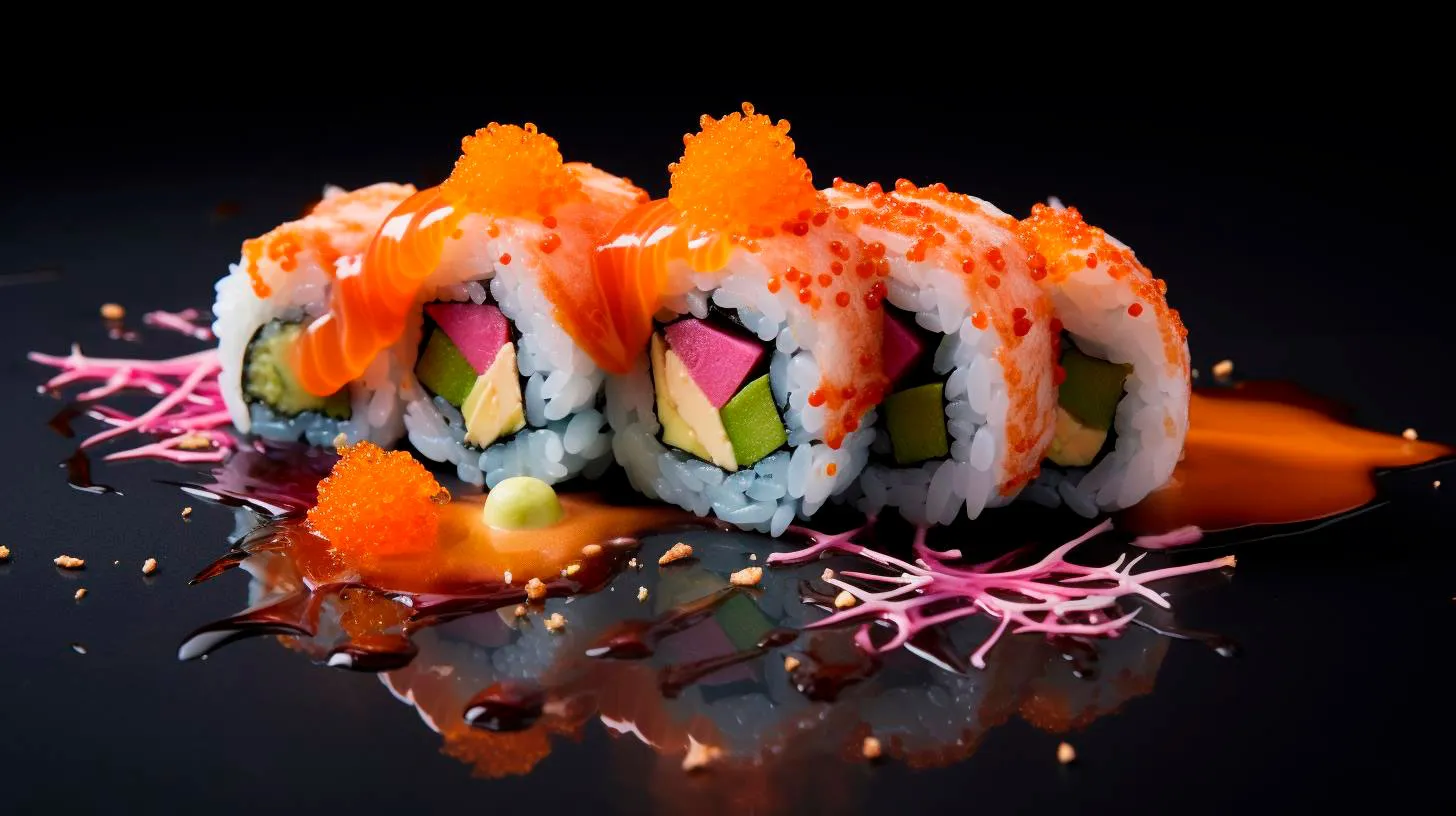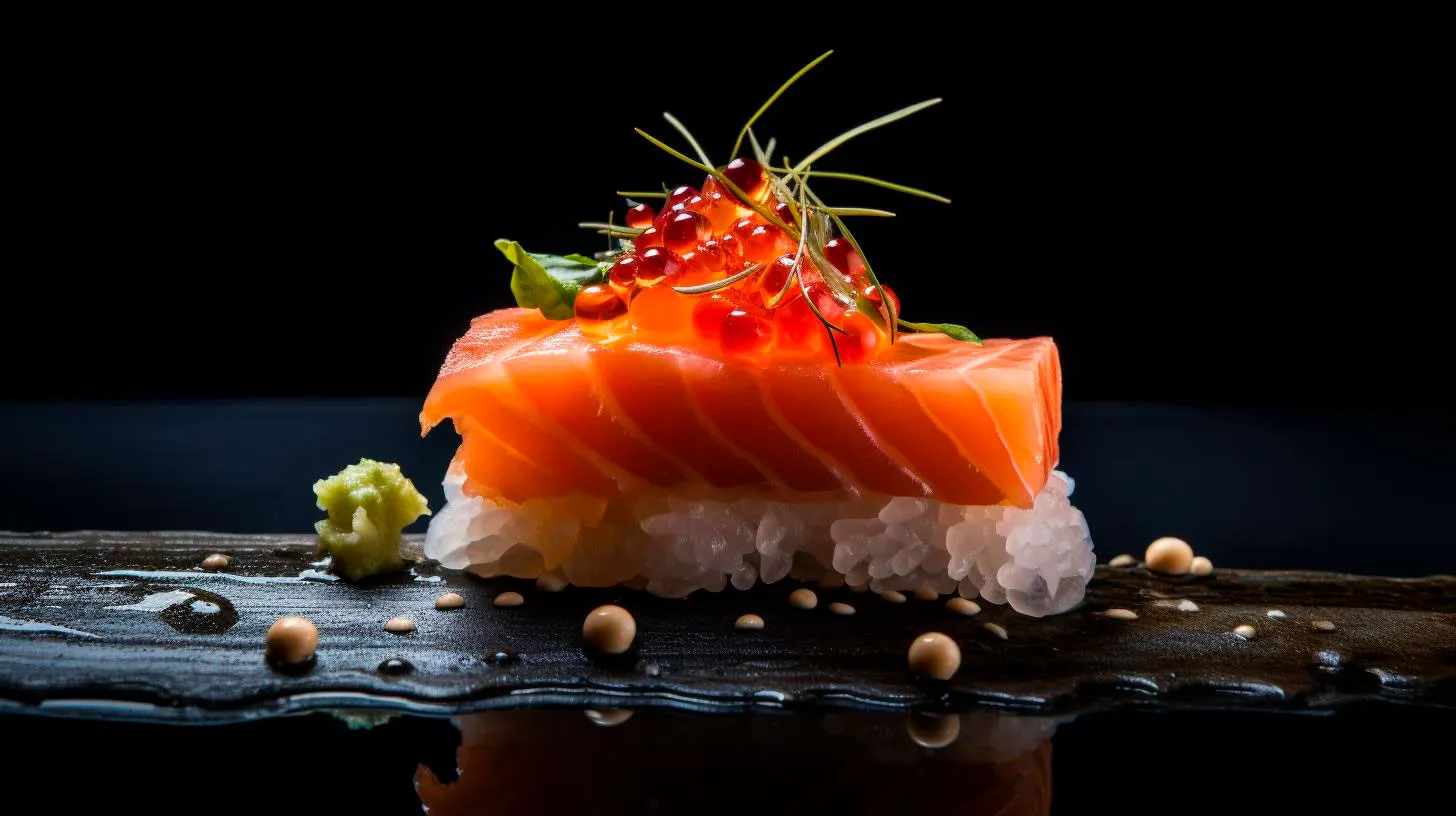Indulge in Sushi Reimagined: Low-Carb and Delicious
Why Low-Carb Sushi?
Traditional sushi is undeniably tasty, but it often comes with a hefty dose of carbohydrates due to the rice used in its preparation. For individuals following a low-carb or keto diet, this can be a significant challenge. But fear not, as low-carb sushi offers a solution that allows you to enjoy your favorite flavors while keeping your carb intake in check. Here’s why you should consider giving it a try:
- Reduced Carbohydrates: Low-carb sushi swaps out the rice for innovative and healthy alternatives, such as cauliflower rice, shirataki noodles, or even cucumber wraps. This significantly reduces the carb content of the dish, making it a suitable option for those watching their carb intake.
- Increased Nutritional Value: By eliminating the rice, low-carb sushi increases the nutritional value of the dish. Cauliflower rice, for example, is rich in vitamins C and K, as well as fiber, making it a healthier choice.
- Weight Loss-Friendly: If you’re looking to shed a few pounds, low-carb sushi can be your best friend. It allows you to enjoy a satisfying meal without consuming excessive calories or spiking your blood sugar levels.
- Variety of Options: One of the great things about low-carb sushi is the variety it offers. From traditional sushi rolls with cauliflower rice to creative alternatives like sushi burritos wrapped in cucumber, the possibilities are endless.
- Easy to Prepare: You don’t have to be a sushi chef to create low-carb sushi at home. With a few simple ingredients and some creativity, you can whip up a mouthwatering low-carb sushi dish in no time.
Low-Carb Sushi: Key Ingredients and Preparation
Now that we’ve covered the benefits, let’s dive into some of the exciting low-carb ingredients you can use to make your sushi reimagined:
1. Cauliflower Rice
Cauliflower rice has become a popular substitute for traditional rice in many low-carb recipes, and sushi is no exception. It provides a similar texture and acts as a blank canvas for all your favorite sushi fillings. Plus, it’s low in carbs and packed with nutrients.
2. Shirataki Noodles
Shirataki noodles, made from konjac yam, are virtually zero carbs and incredibly low in calories. These translucent noodles make a fantastic low-carb alternative to rice, adding a unique texture to your sushi rolls.
3. Cucumber Wraps
For those looking to avoid grains altogether, cucumber wraps can be a refreshing and low-carb option. By slicing cucumbers lengthwise and removing the seeds, you can create a sturdy and healthy wrapper for your sushi fillings.
Once you have chosen your base, it’s time to get creative with the fillings and toppings. You can experiment with various proteins like fresh fish, tofu, or cooked chicken, and add in your favorite vegetables, such as avocado, spinach, or bell peppers. The key is to have fun and create unique flavor combinations that suit your taste buds.
Low-Carb Sushi and Your Health
Aside from being a satisfying meal option, low-carb sushi can offer several health benefits:
- Weight Management: By incorporating low-carb sushi into your diet, you can better manage your weight. The reduced carbohydrate content helps control insulin levels, which can ultimately lead to weight loss.
- Blood Sugar Control: For individuals with diabetes or pre-diabetes, low-carb sushi can be an excellent choice. By minimizing the carbs, you can prevent blood sugar spikes and maintain stable glucose levels.
- Increased Fiber Intake: Many low-carb sushi ingredients are high in fiber, which aids in digestion and promotes bowel regularity. This can have a positive impact on overall gut health.
- Heart-Healthy: The healthy fats found in fish, like omega-3 fatty acids, can benefit heart health by reducing inflammation and lowering triglyceride levels. Including fish in your low-carb sushi can be a great way to boost your heart health.
Conclusion
Low-carb sushi offers sushi lovers a guilt-free option to enjoy this delectable Japanese cuisine. With its reduced carbohydrate content, increased nutritional value, and endless creative possibilities, it’s a win-win for those following low-carb or keto diets. So grab those fresh ingredients and embark on a journey to reimagine sushi in a low-carb and delicious way!
Low-Carb Sushi Substitutes: Enjoying the Flavors without the Carbs
But don’t despair! In this article, we’ll explore some exciting low-carb alternatives that will allow you to indulge in the flavors of sushi without derailing your diet goals.
Cauliflower Rice: The Versatile Miracle
Cauliflower rice is a low-carb dieter’s best friend. This nutrient-dense vegetable makes a fantastic substitution for rice in sushi rolls. Boasting only a fraction of the carbs found in traditional rice, cauliflower rice is the perfect base for your homemade sushi creations. Simply pulse cauliflower florets in a food processor until they resemble rice grains, steam, and drain. Voilà! You now have a keto-friendly rice alternative.
Advantages of cauliflower rice:
- High in fiber and low in carbs, promoting satiety and aiding digestion
- Packed with vitamins C, K, and B6, as well as folate
- A low-calorie option, perfect for weight management
Next time you’re craving sushi, try using cauliflower rice as a substitute and explore a new world of low-carb flavor combinations.
Nori Wraps: Keeping it Seaworthy
In traditional sushi, nori seaweed wraps are used to hold the ingredients together. These nutrient-rich sheets are low in calories and provide a unique umami flavor. Instead of rice, fill nori wraps with your favorite sushi ingredients and enjoy guilt-free.
Key takeaways of nori wraps:
- Low in calories and carbs, making it an ideal choice for weight-conscious individuals
- Packed with vitamins and minerals, including iodine, iron, and calcium
- Supports thyroid function and promotes healthy bones
Experiment with different fillings such as avocado, cucumber, smoked salmon, or even thinly sliced beef. The possibilities are endless and you’ll discover delightful flavor profiles with every bite.
Lettuce Wraps: Crunchy and Refreshing
If you’re looking for a lighter alternative, lettuce wraps are an excellent choice. Lettuce leaves serve as a crunchy vessel to hold your sushi ingredients, providing a refreshing contrast to the savory flavors. Opt for large lettuce leaves such as romaine or iceberg, and wrap them around your favorite fillings. They are not only low in carbs but also rich in vitamins A and K.
Advantages of lettuce wraps:
- Low in calories and carbs, aiding weight management
- Promotes hydration due to its high water content
- Rich in antioxidants, fighting against free radicals and promoting overall health
From tuna salad to spicy shrimp, the combination possibilities are endless. Lettuce wraps offer a refreshing twist on traditional sushi while keeping your carb intake in check.
Cucumber Rolls: Crisp and Cooling
Another stellar option for low-carb sushi substitutes is using cucumber as a wrap. Cucumber rolls are not only visually appealing but also provide a refreshing and cooling aspect to your sushi experience. Slice a long cucumber into thin strips and use them as a replacement for nori wraps or rice-laden sushi rolls. This option is perfect for those seeking a lighter and hydrating alternative.
Key takeaways of cucumber rolls:
- Low in calories and carbs, suitable for weight loss or maintenance
- High water content helps in maintaining hydration
- Offers a good source of vitamins K and C
Fill your cucumber rolls with your favorite ingredients, such as cooked chicken, cream cheese, or even crunchy vegetables. The combination of cucumber’s crispness and the flavors of your fillings will create a delightful sushi experience that won’t compromise your low-carb lifestyle.
Wrap-Up
With these low-carb sushi substitutes, you can still enjoy the flavors and creativity of sushi while staying true to your low-carb or keto lifestyle. Cauliflower rice, nori wraps, lettuce wraps, and cucumber rolls offer a variety of options to suit every taste and dietary goal.
So, the next time you’re craving sushi, swap out the carb-laden rice for one of these nutritious alternatives. Embark on a journey of taste, health, and your desired body composition. Bon appétit!
Ditch the Rice: Innovative Sushi Alternatives to Try Today
In this article, we will introduce you to innovative sushi alternatives that will undoubtedly tantalize your taste buds. Get ready to embark on a culinary adventure!
1. Lettuce Wraps
A healthy and refreshing option to replace traditional sushi rice is lettuce wraps. The crisp and vibrant lettuce leaves act as the perfect vessel to hold all your favorite sushi fillings. These versatile wraps are not only gluten-free but also low in calories, making them an excellent choice for health-conscious individuals. Fill them with a variety of ingredients such as crab sticks, avocado, cucumber, and spicy mayo for a tasty and guilt-free sushi alternative. Key Takeaway: Lettuce wraps are a lighter and healthier substitute for rice, offering a refreshing twist to your sushi experience.
2. Quinoa Sushi
For those seeking a nutritious and protein-packed alternative to traditional sushi rice, quinoa sushi is a perfect choice. Quinoa, a superfood, is rich in fiber, vitamins, and minerals, making it an excellent addition to any diet. By substituting rice with quinoa, you’ll create a flavorful and hearty sushi variation. Experiment with different fillings such as teriyaki chicken, avocado, and pickled vegetables to add an extra layer of taste and texture. Key Takeaway: Quinoa sushi is a wholesome alternative that combines the goodness of quinoa with the flavors of traditional sushi.
3. Cauliflower Rice Sushi
For those following a low-carb or keto diet, cauliflower rice sushi is a game-changer. Cauliflower is an incredibly versatile vegetable that can be transformed into a rice-like texture with ease. By pulsing cauliflower florets in a food processor, you create a rice substitute that is low in carbs and high in nutrients. Customize your cauliflower rice sushi with fillings like grilled shrimp, sliced cucumber, and wasabi mayo to recreate the umami-rich flavors of traditional sushi. Key Takeaway: Cauliflower rice sushi offers a low-carb alternative for those looking to enjoy sushi while adhering to a specific dietary plan.
4. Nori Wraps
If you’re a sushi lover who wants to go completely rice-free, nori wraps are an ideal choice. Nori, the seaweed used to wrap traditional sushi rolls, can be used as a standalone wrap. Fill it with your favorite sushi ingredients and roll it up tightly for a convenient and portable sushi alternative. Nori wraps provide a dose of essential vitamins and minerals, making them a great option for those seeking a nutrient-rich meal. Key Takeaway: Nori wraps offer a rice-free option that is both nutritious and easy to prepare.
5. Sashimi Instead of Rolls
If you’re willing to take a bold step and completely eliminate rice from your sushi experience, why not opt for sashimi instead of rolls? Sashimi refers to thin slices of raw fish or seafood, often served without rice. This minimalist approach allows you to fully appreciate the delicate flavors and textures of the fish itself. Enjoy the natural flavors of tuna, salmon, or yellowtail without the addition of rice, and you’ll be indulging in a true sashimi experience. Key Takeaway: Sashimi offers a rice-free alternative that highlights the fresh flavors of the seafood without any distractions.
Conclusion
While traditional sushi is undeniably delicious, exploring alternative options can bring a new level of excitement to your dining experience. From lettuce wraps and quinoa sushi to cauliflower rice and nori wraps, there are plenty of innovative alternatives to satisfy your sushi cravings. With these alternatives, you can enjoy the flavors and textures you love while catering to specific dietary preferences and restrictions. So go ahead, ditch the rice, and embark on a sensational sushi adventure!
Exploring Healthier Options for Classic Sushi Recipes
In this article, we will explore some innovative ways to create nutritious and delicious sushi rolls, providing you with a guilt-free sushi feast.
1. Incorporating Whole-Grain Rice
Traditionally, sushi is made with white rice. While it provides a soft texture and is easy to work with, it lacks the health benefits of whole grains. By substituting white rice with brown rice, quinoa, or even cauliflower rice, you can boost the nutritional value of your sushi rolls. Whole grains are an excellent source of fiber, minerals, and vitamins, promoting healthy digestion and reducing the risk of chronic diseases.
2. Amping up the Veggie Content
Sushi rolls typically include a variety of vegetables, but we can take it a step further by increasing the veggie content. Experiment with an array of colorful vegetables such as carrots, cucumbers, bell peppers, and avocados to add a burst of flavor, texture, and nutrients to your sushi rolls. These additions not only enhance the visual appeal of your dish but also provide essential vitamins, minerals, and antioxidants.
3. Opting for Lean Protein Sources
Protein is a vital component of any healthy diet, and sushi is no exception. While traditional sushi often includes fatty fish like salmon and tuna, you can choose leaner alternatives such as shrimp, crab, or tofu. These options offer a rich protein source while being lower in saturated fats. Additionally, incorporating plant-based proteins like edamame or tempeh can diversify flavors and cater to vegetarian or vegan preferences.
4. Reducing Sodium with Coconut Aminos
Classic sushi rolls are often dipped in soy sauce, which is notorious for its high sodium content. To make your sushi healthier, consider replacing soy sauce with coconut aminos. Coconut aminos are a popular soy sauce alternative that is lower in sodium and free from gluten and soy. They lend a similar umami flavor and provide essential amino acids, making them a great fit for health-conscious sushi enthusiasts.
Key Takeaways:
- Incorporating whole-grain rice, such as brown rice or quinoa, boosts the nutritional value of sushi.
- Boost the veggie content in your sushi rolls to add flavor and essential nutrients.
- Choose lean protein sources like shrimp, crab, tofu, or plant-based proteins for a healthier sushi option.
- Replace traditional soy sauce with lower-sodium alternatives like coconut aminos.
By exploring these healthier alternatives for classic sushi recipes, you can create a nutritious and satisfying meal while still enjoying the flavors and textures that sushi offers. So why not embark on a sushi-making adventure in your own kitchen and customize your rolls to suit your dietary preferences? With these tips, you can indulge in sushi guilt-free and embrace a healthier, yet equally delicious, sushi experience!



